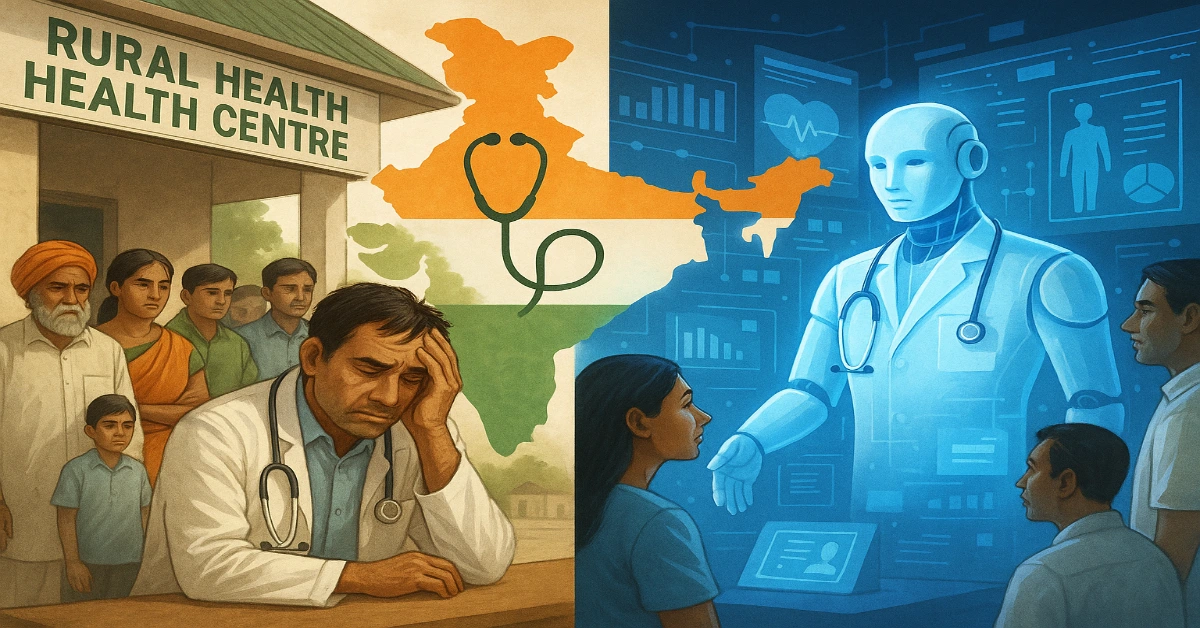Doctor Shortage in India 2025: India stands at a crucial intersection between crisis and innovation. Despite producing over 1,00,000 MBBS graduates annually, India faces a growing MBBS doctor crisis by 2030. It faces a staggering shortage of practicing doctors, only 7.2 doctors per 10,000 people, compared to 23.6 in Brazil and an astounding 95.4 in Cuba and the US.
What is even more surprising that Myanmar, country ravaged by civil war, has 7.6 doctor per 10,000 people and our arch-rival Pakistan about 11.6. It clearly states our standing among immediate neighbours.
In rural India, this ratio drops to a mere 3 doctors per 10,000 people, a situation reminiscent of post-conflict nations like Afghanistan. The implications are devastating: long queues in government hospitals, neglected rural clinics, and millions without timely medical attention.
The paradox is painful, a country that is called the world’s “pharmacy” struggles to find enough physicians to care for its own citizens.
But amid this bleak reality, a quiet revolution is stirring, powered not by stethoscopes and scalpels, but by algorithms and data. Artificial Intelligence (AI) is being hailed as the next big thing , promising to fill the human gap in India’s healthcare ecosystem.
This grim disparity raises two urgent questions:
- How long will it take for India to reach global standards in doctor availability?
- Will technological advances, especially Artificial Intelligence (AI), make the number of doctors less relevant in the future?
The Scale of Doctor Shortage in India 2025
India’s Alarming Statistics
- National average: 7.2 doctors per 10,000 people
- Rural average: 3 doctors per 10,000
- WHO recommendation: 1 doctor per 1,000 population (India has only 1 for every 1,400)
Despite adding over 150 new medical colleges in the last decade, India’s doctor output still trails its population growth.
Moreover, the majority of doctors are concentrated in urban areas, leaving rural and tribal populations underserved.
Global Comparison
| Country | Doctors per 10,000 People |
|---|---|
| Cuba | 95.4 |
| USA | 95.4 |
| Brazil | 23.6 |
| Pakistan | 11.6 |
| Myanmar | 7.6 |
| India | 7.2 |
| Afghanistan | 3 |
Even with ongoing reforms under the National Medical Commission (NMC), it could take 20–30 years for India to reach global doctor density benchmarks.
At this pace, India would take decades to reach the global average doctor density, even with the current expansion of MBBS seats and medical institutions under the National Medical Commission (NMC).
This shortage translates into overcrowded hospitals, delayed diagnoses, and preventable deaths, issues further magnified in districts lacking tertiary healthcare infrastructure.
Read Also: NMC Diwali Bonanza: 812 Medical Colleges & 1,26,600 MBBS Seats for NEET Aspirants
The Promise: Can AI Bridge the Healthcare Gap
For years, policymakers believed the answer to the doctor shortage was simply to build more medical colleges. While that remains essential, it’s not enough. Medical training takes years; infrastructure expansion takes decades. AI, in contrast, offers a leap, a way to “scale intelligence faster than we can train it.”
Globally, AI has shown remarkable progress in medical reasoning. Dr. Robert Wachter, Chair of the Department of Medicine at the University of California, argues that AI could evolve “from an assistant to a credible substitute for human doctors” in certain contexts.
From analyzing radiology images to predicting disease outbreaks, AI systems have begun performing tasks that once demanded years of human expertise.
In India, where 70% of healthcare interactions happen in understaffed primary centers, even partial automation can be transformative.
Entrepreneurs like Munjal Shah of Hippocratic AI are developing systems that aim to replicate bedside empathy and clinical reasoning, targeting not just accuracy but emotional resonance.
If such platforms succeed, India could potentially bridge decades of healthcare inequality within a single decade of digital acceleration.
Read Also: Medical Education in India 2025: MBBS Seat Expansion, AI Integration, and Fee Trends Explained
AI as a Medical Solution
A New Hope in an Overstressed System
Artificial Intelligence has emerged as a potential “digital doctor” that might one day close India’s massive healthcare gap.
Experts like Dr. Robert Wachter, Chair of the University of California’s Department of Medicine, suggest that AI could evolve from a medical assistant to a credible substitute for human doctors.
Earlier computer-based diagnostic systems, such as IBM’s Watson for Health, failed to make an impact due to limited computing power and poor data integration. But the rise of Generative AI models like ChatGPT has revived optimism.
Why AI Feels Promising
- AI can analyze millions of patient cases and detect disease patterns faster than human doctors.
- Systems trained on clinical data can outperform human doctors in certain medical exams and even simulate decision-making in diagnostic settings.
- In remote or underdeveloped areas, AI-powered diagnostic apps and telemedicine tools can provide first-line consultation, improving access where doctors are scarce.
Entrepreneurs such as Munjal Shah, CEO of Hippocratic AI, are developing specialized models designed to deliver safe, scalable, and empathetic medical advice, a mission that aligns closely with India’s need for affordable healthcare expansion.
Read Also: NMC Chairman Proposes AI Integration and 1:1 MBBS-PG Seat Ratio for Medical Education
Efficiency and Empathy Paradox
The Unlikely Rise of the Empathetic Machine
Surprisingly, research has shown that AI-generated medical responses are sometimes rated as more empathetic than those of human doctors.
This finding challenges the traditional belief that machines lack emotional intelligence.
When powered by natural language models and trained on patient-centered communication, AI systems can deliver responses that sound more patient-friendly and less clinical than hurried or overburdened doctors.
Startups Riding the AI Wave
India’s growing digital health ecosystem, boosted by initiatives like Ayushman Bharat Digital Mission, has seen hundreds of startups working on:
- Diagnostic chatbots
- AI-assisted radiology tools
- Predictive analytics for early disease detection
- Digital triage systems for hospitals
These innovations promise a blend of efficiency and empathy, potentially redefining what patient care means in the 21st century.
Persistent Challenges and Risks
Low Healthcare Spending
- India spends around 2% of its GDP on healthcare, far below global averages.
- This underinvestment constrains both human resource development and AI deployment.
- Without robust infrastructure and digital integration, AI tools risk becoming inaccessible to those who need them most.
Bias and Hallucinations
- Even the best AI systems are vulnerable to bias (based on training data) and hallucinations (false or fabricated information).
- A misdiagnosis from an AI system could cause life-threatening errors and severe ethical dilemmas.
Dr. Wachter cautions that these issues remain major roadblocks to clinical trust. As a result, most hospitals currently restrict AI to non-clinical functions, such as:
- Administrative record-keeping
- Appointment scheduling
- Data entry
- Simple triage assistance
Data Privacy and Accountability
- India’s digital health revolution also raises questions about who owns patient data and who is liable for AI-driven errors.
- The lack of clear regulatory frameworks or ethical guidelines could slow adoption or lead to misuse.
Read Also: AI & Modern Technology in Indian Medical Education: Trends, Challenges & Future Roadmap
The Future: Transformation, Not Replacement
AI’s rise in healthcare doesn’t necessarily spell the end for doctors, it signals a transformation in how they work.
Collaboration Over Competition
In the near future, AI will likely serve as a “medical co-pilot”, augmenting doctors’ diagnostic abilities, minimizing paperwork, and helping them focus more on patient care and empathy.
- Radiologists and pathologists, for instance, may rely on AI to analyze large datasets, but final diagnoses will remain human-supervised.
- General physicians could use AI tools to prioritize cases, especially in resource-starved rural hospitals.
The transformation, therefore, is not about replacing doctors but about empowering them with digital intelligence.
A Hybrid Healthcare Model
The ideal future for India’s healthcare system may be a hybrid model:
- AI + Human doctors = Accessible, affordable, and accurate care
- AI handles data-heavy tasks, while doctors bring human judgment, ethics, and empathy.
Read Also: Global Medical Education Crisis: Doctor Shortage, Limited Access & Student Migration
Summary Table: Doctor Shortage in India 2025 and AI Solutions
| Statistic/Issue | India | Comparison (Brazil/Cuba/US) | Key AI Insights |
|---|---|---|---|
| Doctors per 10,000 (national avg) | 7.2 | 23.6 (Brazil), 95.4 (Cuba/US) | AI may become substitute |
| Rural doctors per 10,000 | 3 | Similar to Afghanistan | Empathetic, efficient |
| Healthcare spending (% GDP) | 2% | 18% (US), 9% (Brazil) | Risk of bias/hallucinations |
| Time to reach global doctor levels | Decades | – | Current AI role: admin, triage |
| Full AI replacement (radiologist, pathologist) | Distant | – | Years or decades away |
Balancing Technology and Humanity
India’s healthcare challenge cannot be solved solely through medical colleges or machine learning models.
Bridging the doctor gap requires parallel investment in human and artificial intelligence, training more medical professionals while leveraging AI to enhance efficiency and access.
AI may not replace the doctor’s healing touch, but it can amplify it, making quality care faster, fairer, and more inclusive.
The true test of India’s healthcare future lies in how wisely it balances innovation with empathy, and technology with trust.

